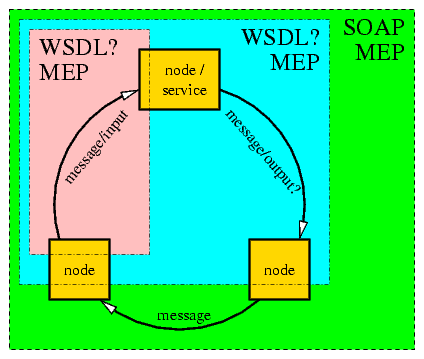- From: Jacek Kopecky <jacek@systinet.com>
- Date: 21 Feb 2003 18:20:05 +0100
- To: "Amelia A. Lewis" <alewis@tibco.com>
- Cc: Martin Gudgin <mgudgin@microsoft.com>, Jeffrey Schlimmer <jeffsch@windows.microsoft.com>, WS Description WG <www-ws-desc@w3.org>
- Message-Id: <1045848005.6494.125.camel@krava.in.idoox.com>
Amy, I have two questions (with some discussion) below:
1) Are WSDL MEPs from the point of view of the service?
SOAP MEPs (similar to what I would call abstract MEPs) are describing
the message flow among a given set of nodes (two or more, usually). They
informally distinguish between different messages, and they formally
distinguish between different nodes. SOAP MEPs have no notion of a
service.
Now WSDL MEPs (the ones necessary for describing operations) have a
notion of a service (a special kind of node, I guess) and describe only
the part of the appropriate abstract MEP that actually concerns the
service.
The attached image shows two options of what WSDL MEPs are. The SOAP MEP
in the image (green/biggest box) has three nodes (to better demonstrate
my point), but the WSDL MEP can be understood to have the service and
"the world" (blue/middle box) or only two communicating nodes
(pink/small box). Now which ones were you doing? Which ones do we want
to do? Which ones do we want abstract?
IMHO the smalles ones are interfaces, the middle ones are interactions,
the big ones are systems. If we do interfaces, we do the smallest ones.
Also, I believe abstract MEPs should be the big ones; probably providing
decomposition into both smaller types. WSDL MEPs would then reference
the component MEPs, not just the whole big MEPs.
2) Was the Scottsdale decision meant to forbid more-than-two-nodes WSDL
MEPs or was it just that this WG would not specify them?
If such MEPs are forbidden, then surely we are doing the smallest MEPs.
What you have written below seems to suggest this approach.
If more-than-two-nodes MEPs are just out of scope, we would be doing the
bigger (blue) MEPs. If so, cases with more than two nodes should still
be considered so that we don't end up with something that makes
describing/using such MEPs complex or impossible.
I hope we'll soon all be clear (and it may be just me who needs
clarification) on all this. 8-)
Jacek Kopecky
Senior Architect, Systinet Corporation
http://www.systinet.com/
On Fri, 2003-02-21 at 16:58, Amelia A. Lewis wrote:
> Dear Jacek,
>
> Thanks for the comments.
>
> On 21 Feb 2003 16:41:36 +0100
> Jacek Kopecky <jacek@systinet.com> wrote:
> > I think it's the good direction. I do have comments/questions:
> >
> > The MEPs say nothing about where the 'in' messages come from or where
> > the 'out' messages go to, which may be confusing. Although I first
> > thought it's OK, the MEP8 below suggests otherwise. Without the comments
> > specifying the sources/destinations, the MEP would be extremely abstract
> > and confusing.
>
> Well, I had understood that the Scottsdale face-to-face ruled out
> modeling of intermediaries in MEPs, or more than two node roles. If
> so, then MEP8 won't fly, since it's both.
>
> > Who will specify (and where will that be) the relationships between SOAP
> > MEPs, possible abstract MEPs (if anyone comes up with such beasts) and
> > WSDL MEPs?
>
> I thought that we *were* defining abstract MEPs, here.
>
> If so, then the architecture would presumably call for SOAP MEPs to be
> defined with reference to the abstract MEPs, and likewise the WSDL
> MEPs would refer to either SOAP or abstract MEPs. The WSDL MEPs might
> be no more than "this is how this particular abstraction is
> represented syntactically."
>
> But I might not be fully in synch with Gudge and Jeff on that one. Guys?
>
> > For example, SOAP Request/Response maps to MEP2, SOAP
> > Response maps either to MEP4 or MEP2, and
>
> Right, presumably if there were abstract MEPs, then the MEPs that SOAP
> references would specify which.
>
> > a potential SOAP Req/Resp MEP
> > involving one intermediary would map to two WSDL MEPs - MEP2 for the
> > service and MEP8 (below) for the intermediary.
>
> I thought that this was out of scope. Intermediaries, in particular,
> are severely problematic to model, since SOAP has a bit of a split
> personality about whether they are visible or not. At present,
> insofar as I am aware, WSDL does not attempt to model any information
> about intermediaries, at all.
>
> So, in WSDL, if the intermediary were visible, it would be a service,
> and the fact that it mediated between a particular service and its
> clients wouldn't be visible. It would expose a MEP2; the fact that it
> is (behind the scenes) using a MEP2 on the "real" service (with itself
> in a client/forwarding role) isn't visible in the WSDL.
>
> Or such is my understanding.
>
> > And that's not
> > considering describing the client in a WSDL. 8-)
>
> Yes, but we haven't developed a web CLIENT description language. If
> it isn't a service, it isn't our problem, is it? Except insofar as
> the SERVICE description should be adequate to allow a client to
> actually use the service.
>
> Amy!
Attachments
- image/png attachment: meps.png

Received on Friday, 21 February 2003 12:20:10 UTC